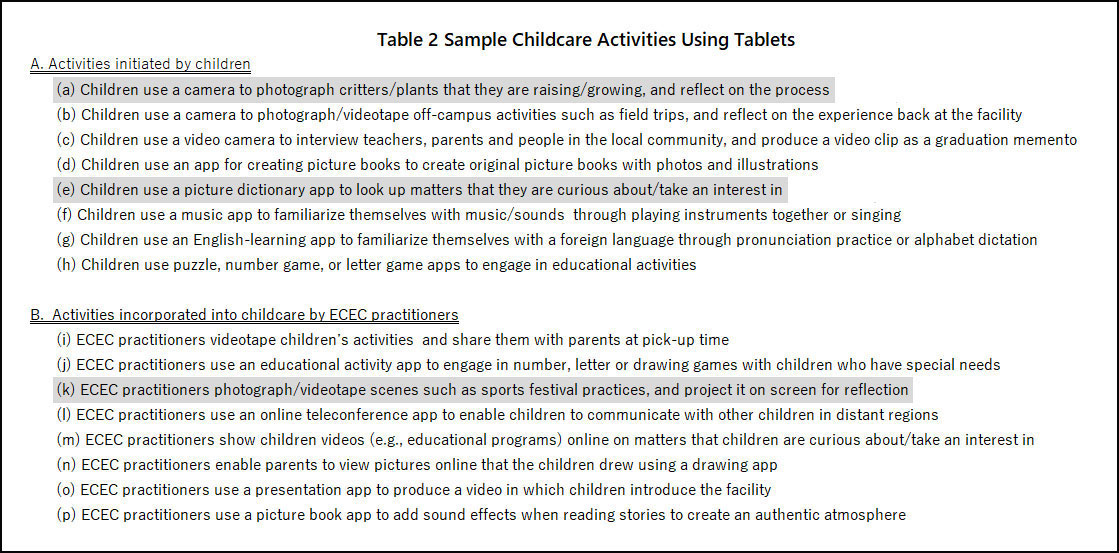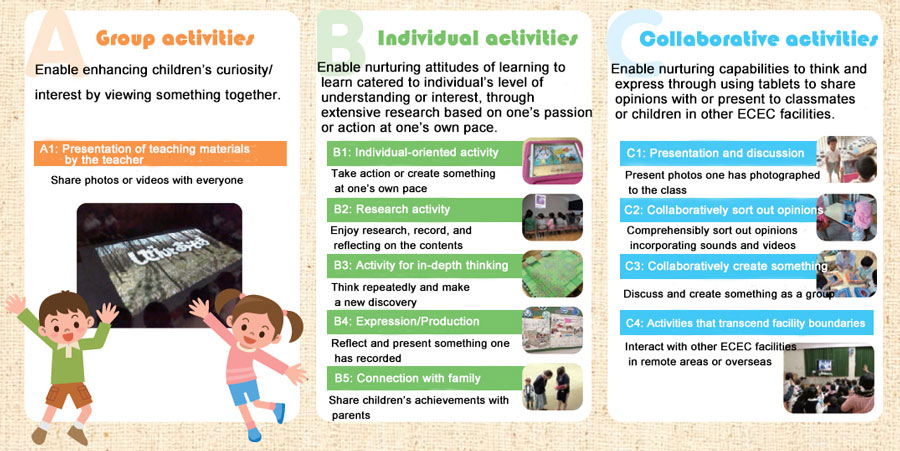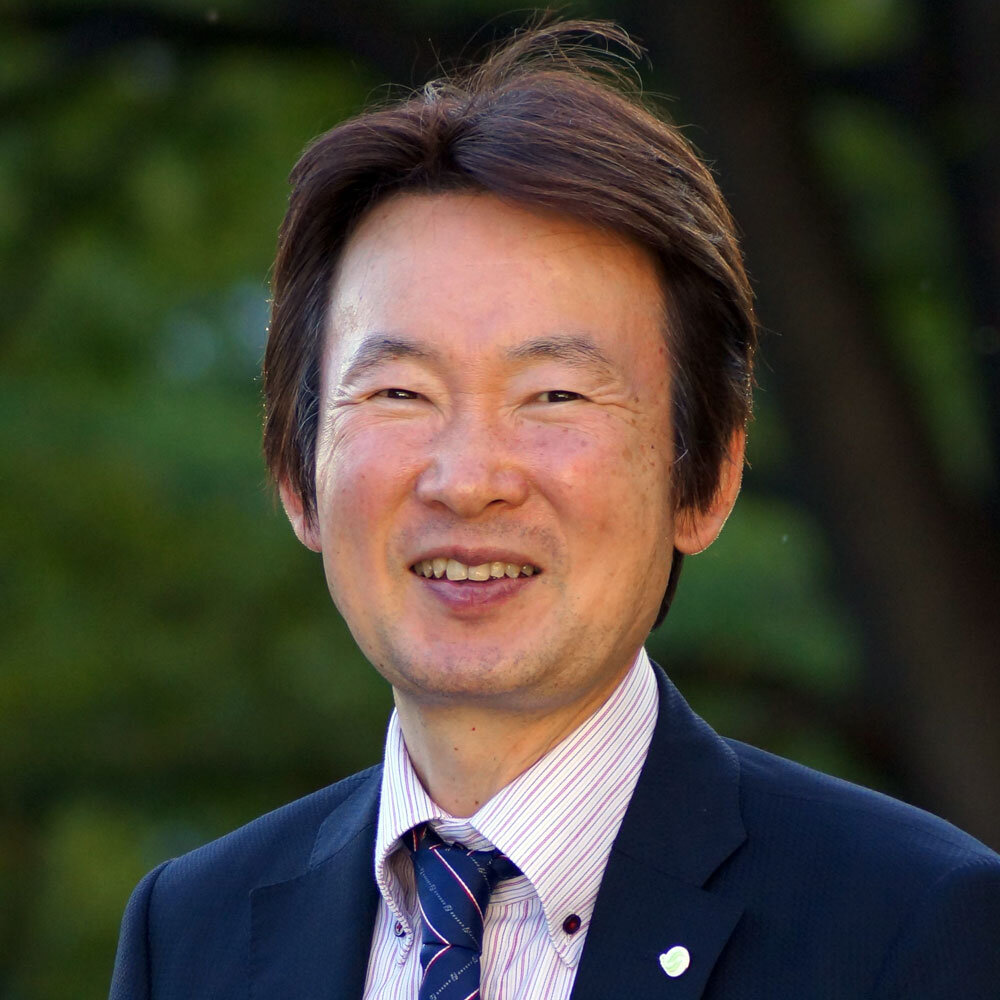The Core Curriculum for Teacher Training released in 2017 states that one of the objectives in childcare methodology is to enable practitioners in Early Childhood Education and Care (ECEC) to "understand how to use information devices and teaching materials while considering them in relation to the characteristics of each area and experiences of children, and to use them to organize childcare activities," thereby calling for ECEC practitioners to learn ways to develop childcare activities considering the explicit use of information devices and teaching materials (Core Curriculum for Teacher Training, 2017).
Every year since academic year 2009 (April 2009-March 2010), we have carried out surveys on the use of media in childcare targeting 1,000 ECEC facilities nationwide, taking into account the difference between public and private facilities as well as among prefectures. Table 1 summarizes triennial survey results on media usage in kindergartens and other ECEC facilities (multiple answers allowed).
| Table 1 Media Usage in Childcare | |||
| 2009 | 2014 | 2018 | |
| Video/DVD | 73.0% | 85.0% | 72.9% |
| Digital camera | 66.4% | 84.6% | 78.9% |
| Audio device | 73.0% | 94.2% | 91.1% |
| TV programs for children | 26.5% | 28.8% | 45.4% |
| Optical projector | 16.9% | 15.0% | 16.0% |
| OHP | 14.2% | 19.6% | 15.0% |
| PC | 13.3% | 40.4% | 38.6% |
| Tablet devices | - | 3.8% | 8.2% |
| (Questionnaires were distributed to 1,000 ECEC facilities. Values represent the ratio of facilities that use the specific media to all facilities that responded.) | |||
While values differ slightly from year to year, the usage ratio is high for audio devices such as CD players or cassette decks for playing music, videos/DVDs for showing contents such as security, disaster prevention or fictional stories, and digital cameras suitable for recording children's activities. Meanwhile, the usage ratio for tablet devices is still low due to their costliness, although compared to digital cameras, they have larger screens and better resolution which provide clearer images.
When applying the media used in childcare listed in Table 1 to the information devices mentioned in the Core Curriculum for Teacher Training, it is presumably easy to envision the use of audio devices, videos/DVDs and digital cameras in childcare. On the other hand, it is most likely difficult to explicitly envision using the media listed in Table 1 aside from the top three.
This article considers how to conform to the Core Curriculum for Teacher Training by exploring initiatives to support ECEC practitioners and students in teacher training courses for ECEC in developing practical childcare activities while envisioning the use of tablet devices--a media less frequently used in childcare among those listed in Table 1.
In academic year 2014, we devised sample childcare activities that incorporate tablet devices (see Table 2), and conducted a questionnaire survey targeting 1,000 ECEC facilities nationwide asking them to rate each activity on a five-point scale ranging from "1: Very interested in implementing" to "5: Not at all interested in implementing." We conducted a one-way analysis of variance for items in groups A and B as listed in Table 2, and found a significant difference within both groups (Group A: F(7,1909)=16.4,p<.01; and Group B: F(7,1905)=18.2,p<.01). We then conducted a multiple comparison and detected a significant difference at the 1% level between (a) and (e) and the other items within A, and between (k) and the other items within B. Specifically, it was revealed that ECEC practitioners are highly motivated to implement the following activities listed in Table 2: "(a) Children use a camera to photograph critters/plants that they are raising/growing, and reflect on the process;" "(e) Children use a picture dictionary app to look up matters that they are curious about/take an interest in;" and "(k) ECEC practitioners photograph/videotape scenes such as sports festival practices, and project it on screen for reflection" (Hotta et. al, 2014).

During academic year 2017, we created "Sample Activities for Promoting the Use of Tabletdevices in ECEC" to illustrate scenes using tablet devices in ECEC in more detail, and outlined such scenes as shown in Figure 1 (Hotta et al., 2017).

Furthermore, in academic year 2018, we conducted a questionnaire survey targeting 1,000 ECEC facilities nationwide asking them to rate 14 activity scenes that use tablet devices, as outlined in the abovementioned "Sample Activities," on a five-point scale. We conducted a one-way analysis of variance on the 14 activity scenes and found a significant difference (F(13,3698)=6.53,p<.01). We then conducted a multiple comparison and consequently found a significant difference between 'Let's observe the tanabata (i.e., star festival) constellation!' in "B1: Individual-oriented activity" and 'Let's convey children's activities!' in "B5: Connection with family," and many of the other activities (Hotta et al., 2018). With regards to 'Let's observe the tanabata constellation!,' some ECEC facilities organize a sleepover and as part of this program, children observe constellations in the night sky; however, this activity can be affected by the weather. By attaching a sheet to the ceiling of a room and using a projector to project constellations displayed on an app, children can observe constellations at any time regardless of the weather. ECEC practitioners were most likely able to conjure up such an image. As for 'Let's convey children's activities!' it is common for ECEC practitioners to use digital cameras or video cameras and photograph or videotape children's activities to share with parents. Such sharing is usually conducted by preparing a television or other projector device in a daycare center room. 'Let's convey children's activities!' was evaluated highly for its convenience of enabling communication with parents in any place including the daycare center yard using just a tablet device, without the need to prepare a projector.
When developing ECEC activities, it is not easy to envision the use of media other than audio devices, videos/DVDs or digital cameras. We aim to continue expanding on our research findings in order to support in any way possible the development of ECEC activities that incorporate media, through initiatives to help simulate effective media usage and through publishing such results, as we have done in this study.
Note) This article cites part of and supplements "Study on Initiatives for Using Tablets in ECEC" published in Papers from 30th Annual Conference of Japan Society for Educational Technology and "Evaluation on Ease of Implementation for Scenes Using Tablets in ECEC" published in the 25th Annual Conference of Japan Association for Educational Media Study.
References
- Study group on the current state of the Core Curriculum for Teacher Training, 2017, Core Curriculum for Teacher Training November 2017. Cited from: http://www.mext.go.jp/b_menu/shingi/chousa/shotou/126/houkoku/1398442.htm (accessed October 26, 2018)
- Hotta, Hiroshi and seven others, 2014, "Study on Initiatives for Using Tablets in ECEC," Papers from 30th Annual Conference of Japan Society for Educational Technology, September 2014, pp.557-558.
- Hotta, Hiroshi and six others, 2017, "Production of Sample Activities for Promoting the Use of Tablets in ECEC," 70th Conference of Japan Society of Research on Early Childhood Care and Education, May 2017, p.404.
- Hotta, Hiroshi and two others, 2018, "Evaluation on Ease of Implementation for Scenes Using Tablets in ECEC" 25th Annual Conference of Japan Association for Educational Media Study, November 2018, pp.106-107.



 Hiroshi Hotta
Hiroshi Hotta










